Where there is smoke,
there is . . .
Chuck Kendall is a Senior EMC Consultant with CKC Laboratories,
Inc. in Mariposa, California. In his early days of EMC, he
was asked to attend a military test with his brother, the
late Chris Kendall. In the process of ‘gaining some
experience,’ he had quite an experience. I think the
story is the most humorous told from Chuck’s perspective.
“My brother, Chris, invited me to tag along on a military
project at Raytheon in Santa Barbara. Arriving early, we signed
in and received our escort badges. We soon arrived at one
of their large EMC labs, where one of their systems was set
up and ready to test. Chris spoke with the Raytheon project
engineers to clarify what tests we were to perform that day.
If my memory serves me right, I was assigned to perform a
magnetic loop probe test (MIL-STD-461A for the Navy), with
one of the Raytheon engineers assigned to support me.
Some time after Chris got me started testing, he came up to
me and said, ‘I need to go to another room and assist
an engineer with a different project. Just keep on doing what
you’re doing and I’ll be right back.’ With
that he and the Raytheon engineer walked off. So, I kept monitoring
the magnetic test. Then, ‘my’ engineer said he
had to retrieve a needed item and he too would be right back.
He informed me that if anything out of the ordinary happened,
just push the emergency shut off button. He pointed out the
location of the button to make sure that I understood where
it was.
Once he was gone, I went back to monitoring the test. Just
then, I began smelling something cooking and it wasn’t
even close to lunchtime. As I turned around to check out the
system I was testing, whispers of smoke were emanating from
the vents in a bottom panel. Remembering my last instructions,
I reached for the large, red emergency shut-off button. The
power instantly went off and the smoking stopped. As the smoke
was clearing, I heard a commotion in the hallway, outside
the room I was working in. ‘How did they know that the
system I was working on would go down’ I was wondering.
I also recalled that I was there alone, although I was supposed
to be under constant escort. So, not wanting to reveal my
delicate situation, I listened quietly at the door until I
heard a voice that I thought I recognized. I cautiously opened
the door and found myself looking into a hallway of about
20 people. When we arrived earlier, the sight of four people
would have been a crowd. I became less worried about where
my escort was, for I suddenly had plenty of escorts. All at
once, ‘my’ engineer barged by me like I was a
flowerpot, and informed everyone who was listening, that all
of the systems on this side of the building had been shut
down as well.
‘My’ engineer then asked me why I pushed the big
red button and in the process caused all of the commotion.
In reply, I pointed to the bottom panel of the system, and
told him that because the device was smoking, I hit the emergency
shut-off. He then asked, ‘well, how much smoke was coming
out of the system?’ Having recently retired from active
duty Air Force, in the nuclear weapons field, I was trained
to take any indication of smoke very seriously. So, I took
his inquiry seriously and described the amount of smoke to
him in a serious fashion. After hearing me out, ‘my’
engineer said to everyone within earshot that the whole occurrence
was probably part of normal operation. And, having said that,
he confidently switched the power to the system back on. It
wasn’t very long before the system responded; only this
time no one had to push the big red button. After an exciting
electrical pop, the system shut down all on its own. Once
the initial bewilderment wore off, ‘my’ engineer
hurriedly removed the panel cover to investigate. The first
thing we all noticed is that the ribbon cables that were draped
over the three phase EMC filter were different in color and
form. Shades of black were evident in the fragments of cable
that were left dangling. What was previously a four-pole filter
was now a three-pole filter. An entire pole of the filter
was gone along with much wiring!
Needless to say, my test project came to an abrupt halt. In
the car on the way home, I asked Chris to never again leave
me at a customer site until I had more experience. After such
an introduction, I thought that my first military test was
going to be my last.” |
Australia – Welcome
New Chapter!
Welcome to the newly founded Victoria IEEE EMC Chapter in Australia!
The Chairman of the Victoria Chapter is Malcolm Mulcare, malmulcare@pacific.net.au.
The EMC Society Board of Directors, Chapters, and Members welcome
this newly formed EMC Chapter. Good luck to the Chapter, its Chairman,
and Officers!
Japan
Professor Fujiwara, last year’s Chapter Chair, reports that
the IEEE EMC-S Japan Chapter holds regular technical meetings
ten times per year in cooperation with the IEEE EMC Society Sendai
Chapter. These meetings are also co-sponsored by the EMC Technical
Group of the Institute of Electronics, Information, and Communication
Engineers (IEICE). In addition, some non-regular technical meetings
such as an EMC workshop and joint meeting in Asia are also held.
More than 150 technical reports are normally presented every year.
In 2005, 172 papers were presented as follows: On January 20–21,
March 10, April 22, May 25 -26, June 9–10 and July 28-29,
the technical committee meetings on EMC were held in NICT Okinawa,
Tokyo, Kanagawa, Awaji-island, Sapporo and Tokyo, respectively.
The numbers of presented papers were 30, 15, 9, 9, 22 and 18,
respectively. For the meeting in Tokyo in July, a special lecture
on “Electrical Contacts and EMC” was presented by
Emeritus Professor Tasuku Takagi. On September 8–9, October
27–28, November 25, and December 9, the technical meetings
were held in Kyoto, Akita, Tokyo and Gifu, respectively. The numbers
of presented papers were 22, 26, 8, 13 and 18, respectively. A
special workshop on EMC was held on November 1–2 in Izu.
Eleven formal presentations were made at this workshop. The first
Pan-Pacific EMC Joint Meeting, PPEMC’05 for short, which
was also cosponsored with an IEICE EMC Technical Committee, was
held in Awaji-island on May 27. There were five invited presentations
by Professors Gao Yougang and Su Donglin from China, Professor
Dong Chul Park from Korea, Dr. Er-Ping Li from Singapore, Professors
Osami Wada and Jianqing Wang from Japan. The second PPEMC’06
will be held on May 25-26, 2006 at the 50th Anniversary Hall of
Okayama University, Okayama, co-sponsored by IEICE. In addition,
a lecture meeting on bio-electromagnetics was held in Nagoya on
November 17, which was also cosponsored with the IEEE Nagoya Section.
Dr. Peter Dimbylow and Dr. Peter Wainwright presented two lectures
from Health Protection Agency in U.K. The Japan EMC Chapter is
very pleased to have received the “Special Chapter Recognition
Award” from the IEEE EMC Society at the 2005 International
Symposium on EMC. The award was presented to recognize the 25th
anniversary of the Japan EMC Chapter, which was founded in 1980
and was the first Chapter established outside the United States.
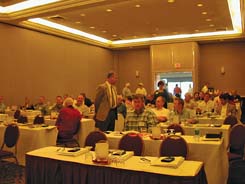 |
| There were many technical discussions
between sessions at the Aerospace EMC Tech Tour in Melbourne. |
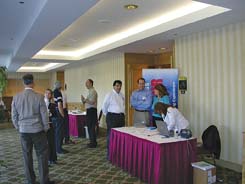 |
| The registration area was busy prior
to the start of the Aerospace EMC Tech Tour in Melbourne on
February 27. |
 |
| Melbourne Chapter Chair Bruce Crain
of Northrop Grumman (far left) posed with speakers Vince Rodriguez
of ETS-Lindgren, James Young of Rohde & Schwarz, and Ken
Javor of EMC Compliance (from left) prior to the start of
the February seminar. |
Melbourne
Bruce Crain, Melbourne EMC Chapter Chair,
reports that on February 27, the Melbourne EMC chapter hosted
the “Aerospace EMC Tech Tour” at the Hilton Melbourne
Rialto Place Hotel in Melbourne, Florida. ETS-Lindgren, Rohde
& Schwarz, and Conformity Magazine sponsored this event. Speakers
were James Young of Rohde & Schwarz, Vince Rodriguez of ETS-Lindgren,
and Ken Javor of EMC Compliance. This half-day seminar drew about
50 attendees from the local area. Ken Javor started things out
with a presentation on “Mil-Standard EMC Testing of Products
and Aircraft,” focusing on CS114, RE101 and RE102 testing.
Ken is a member of the MIL-STD-461 technical committee and brought
a wealth of historical perspective to the origins and rationale
of these tests. Vince Rodriguez then gave a presentation on “Anechoic
Chamber Solutions for Antenna Pattern Measurements.” Vince
has a great deal of experience in the design of anechoic chambers
and gave a comprehensive overview of the types of anechoic chambers
used for antenna pattern measurements. James Young rounded out
the day’s presentations with a discussion about “Improving
the Accuracy of EMI Measurements.” He discussed the subtleties
of using spectrum analyzers for EMI measurements versus tuned
EMI receivers, as well as issues associated with achieving low
noise EMI measurements. After the day’s technical presentations,
everyone enjoyed a complimentary reception with a drawing for
some very nice door prizes, including gift cards, memory sticks,
a DVD player and an iPod Nano. The Melbourne Chapter thanks the
corporate sponsors, the speakers, and Janet O’Neil of ETS-Lindgren,
for making the local arrangements. For more information on Melbourne
Chapter and Section activities, please visit www.ieeemelbourne.org.
 |
| The 2006 EMC Seminar Committee included
(from left) Dr. Todd Hubing, Jim Blaha (L. S. Compliance),
Teresa White (L. S. Compliance) and Don Koller (Rockwell Automation). |
 |
| Posters were used effectively to
keep Milwaukee’s EMC 2006 Seminar organized and on schedule. |
 |
| Committee member Teresa White of
L.S. Compliance was always smiling and always helpful at Milwaukee’s
2006 EMC Seminar. |
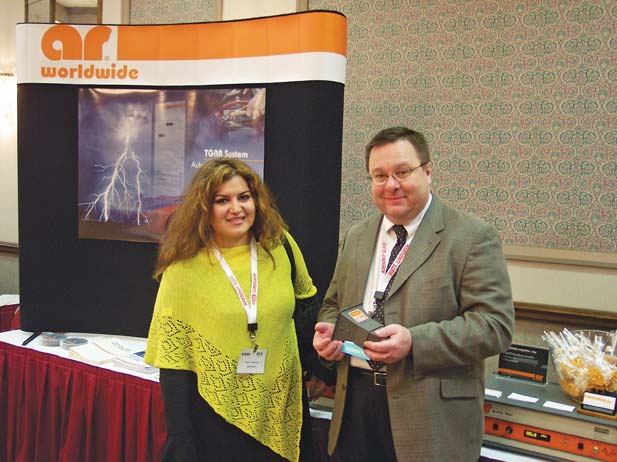 |
| Negar Farzinnia (left) of Adaptive
Micro Systems and John Whitney of AR Worldwide discussed horn
antennas at the 2006 EMC Seminar in Milwaukee. |
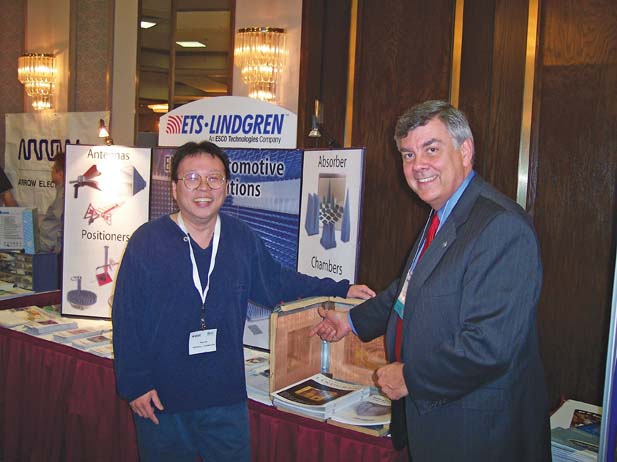 |
| Ping Lee (left) of Rockwell Automation
and Frank Krozel of Electronic Instruments Associates discuss
uses for copper screening other than EMI. |
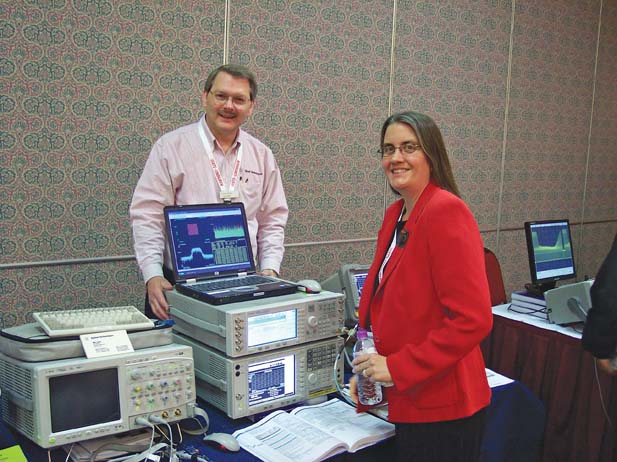 |
| Tom Holmes (left) of Agilent Technologies
and Toni Ruel of Astronautics met up in Milwaukee. |
 |
| Russ Davis (left) of Electronic Instruments
Associates and Mike Steinike of General Electric Healthcare
Systems apply Dr. Hubing’s lecture notes to the real
time measurements of EM Scan. |
 |
| Steve Laya (left) of Elite Electronic
Engineering provides information on his company’s services
at the 2006 EMC Seminar in Milwaukee. |
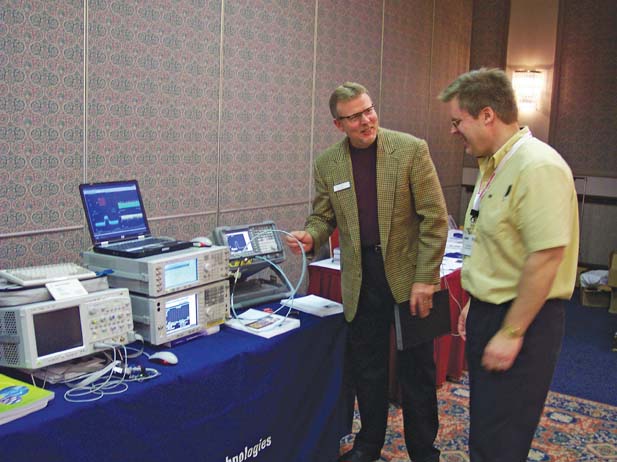 |
| Mike Larsen (left) of Agilent Technologies
and Mike Steinike of General Electric Healthcare Systems review
potential bounce in a cable. |
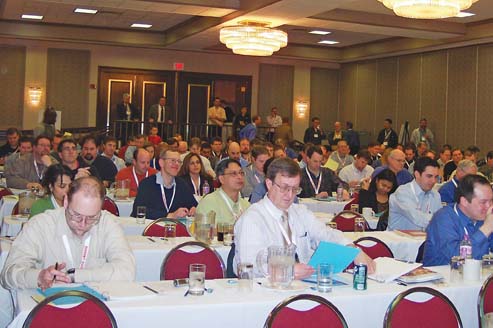 |
| Nearly 140 attendees listened intently
to Dr. Todd Hubing’s presentation at the Milwaukee Chapter’s
2006 EMC Seminar. |
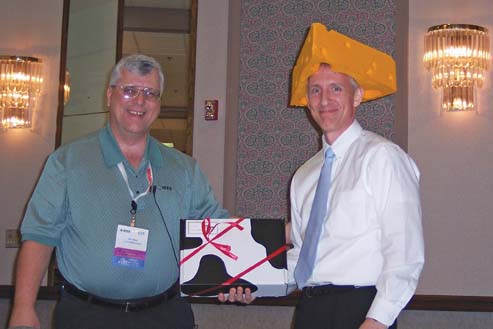 |
| Jim Blaha (left) presented Dr. Hubing
with a “Wis-cow-sin” gift box, for taking his
time to teach as the headline speaker the EMC 2006 Seminar
in Milwaukee. |
Milwaukee
“Extremely well organized” and “Very well structured
program” are the leading feedback comments from attendees
of the 2006 EMC Seminar sponsored by the Milwaukee Section EMC
Chapter. The 2006 EMC Seminar, now in its fifth consecutive year,
was held on March 28th. Attendance consisted of 137 paid registrations
with 18 sponsorships by various exhibitors. Companies leading
the way with paid attendees were: General Electrical Healthcare
Systems, Rockwell Automation, Johnson Controls, Badger Meter,
Magnetek and Plexus Technology Group. The featured speaker for
the 2006 EMC Seminar was Dr. Todd Hubing from the University of
Missouri - Rolla. Dr. Hubing lectured on “Printed Circuit
Board Layout to Reduce Noise Emissions and Susceptibility.”
For the first time in the Milwaukee EMC Seminar Series, the students
were awarded .6 Continuing Educational Units (CEU’s). The
IEEE acknowledged the educational content of this seminar as meeting
the guidelines and criteria for all of its professional development
programs. This seminar followed all of the International Association
of Continuing Education and Training (IACET) adopted guidelines
and criteria for IEEE’s professional development programs.
The sit down luncheon was co-sponsored by Electronic Instruments
Associates, Leader Tech, L. S. Research and L. S. Compliance.
The luncheon was held in the grand ballroom surrounded by all
of the exhibitors. A total of 170 were served lunch. Immediately
following the afternoon break, an exhibitor raffle was held and
enjoyed by all. Following the raffles, a special presentation
was made to Dr. Hubing by Jim Blaha to acknowledge the EMC Chapter’s
appreciation for his time. This carried a special acknowledgment
for coming back to Wisconsin during “U of M’s Spring
Break.” The presentation consisted of a “Wis-cow-sin”
Gift Box and the traditional “Cheese Head.” Dr. Hubing,
a Wisconsin native, warmly received the triangular wedge of cheese.
After the seminar, AR Worldwide sponsored an exhibitor’s
reception. This year’s local planning committee, consisting
of Teresa White, Don Koller, and Jim Blaha are already analyzing
the data collected from the 128 returned seminar surveys. The
planning has already started for the 2007 EMC Seminar. Enjoy the
associated photos and plan on joining us in Milwaukee - Spring
of 2007.
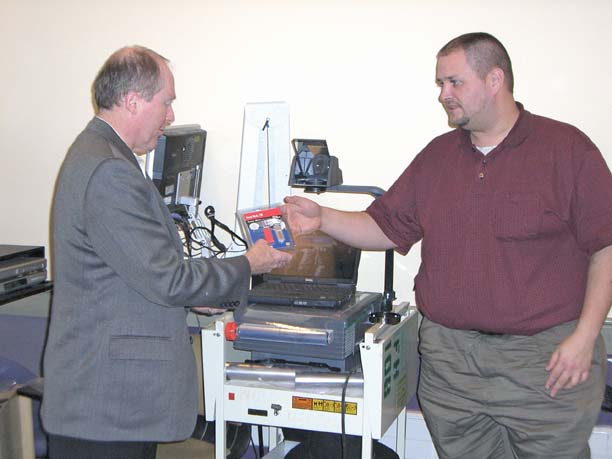 |
| Derick Skouby (right) of ElectroMagnetic
Investigations, Chapter Chair, presents the speaker’s
gift and offers thanks from the Oregon and SW Washington Chapter
to Jim Skelly of Cybershield following his January presentation. |
 |
| Professor Robert Olsen of Washington
State University giving the February technical presentation
on BPL communications systems in Portland, Oregon. |
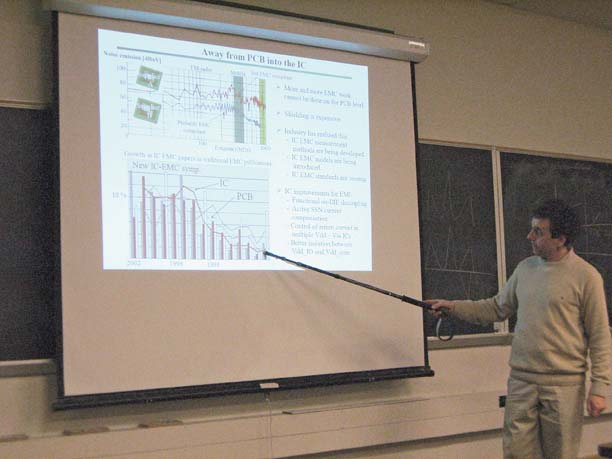 |
| Dr. David Pommerenke of the University
of Missouri-Rolla giving his presentation on “Advanced
ESD and EMI Analysis Methods” at the University of Portland. |
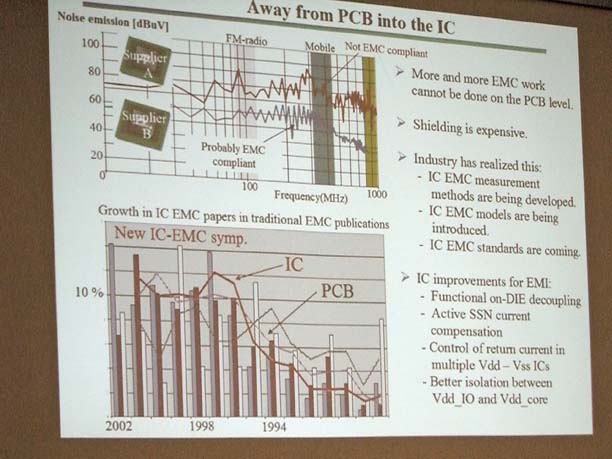 |
| A close up of the slide presented
by Dr. David Pommerenke at the March Oregon and SW Washington
Chapter meeting. |
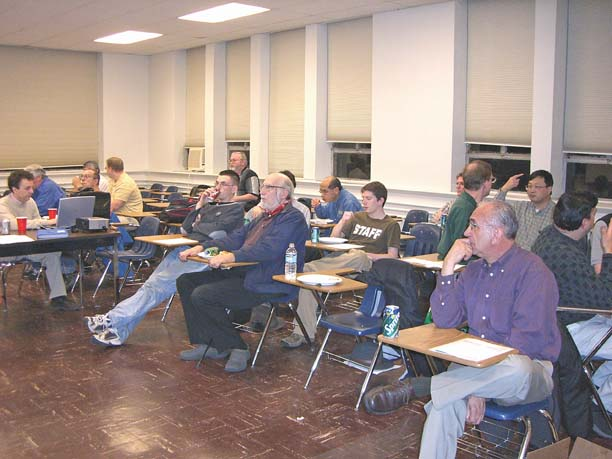 |
| Post-gustatory networking and anticipation
as the speaker (far left) readies his laptop for the presentation
at the March meeting of the Oregon and SW Washington Chapter. |
Oregon and SW Washington
William Moyer reports that the Oregon and SW Washington Chapter
started their first quarter 2006 technical presentations program
with a presentation at the University of Portland in January by
Jim Skelly on the increasingly important topic of “Coated
Plastics in EMC Applications.” President of Cybershield
since 2001, Jim received an Industrial Engineering degree from
the University of Rhode Island and an MBA from Northeastern University.
Jim worked for Texas Instruments for over 20 years in sales, marketing,
and program management positions. After leaving TI, he was Sales
VP at Airborn, a leading high reliability connector manufacturer,
was President of Thermalloy, an electronic component manufacturer,
and was President of EL Specialists, a start-up that developed
an innovative electro luminescent technology. Use of conductive
coatings in EMI shielding systems is expanding due to the growing
use of injection molded plastic enclosures and components in today’s
electronic devices. Faster semiconductor clock speeds are increasing
the challenges for robust EMI shielding systems, while electronic
device form factors are continuing to shrink. Plastics being non-conductive
by nature, plastic enclosures do not mitigate EMI without incorporation
of conductive shielding materials to meet regulations and to ensure
reliable device performance. Conductive coatings essentially consume
no volume inside an electronic device and if applied properly
can assist design engineers in meeting cost targets. The presentation
reviewed the shielding effectiveness of many conductive coatings
systems and included information on design considerations for
effective utilization of conductive coatings in electronic devices.
The presentation concluded with a review of several current production
applications and their EMI shielding systems. At the February
Chapter Meeting, Dr. Robert G. Olsen presented a “Technical
Overview of Broadband Powerline (BPL) Communication Systems,”
the subject of much of his current work. Associate Dean of the
College of Engineering and Architecture and the Boeing Distinguished
Professor of Electrical Engineering at Washington State University,
Pullman, WA, USA, he received his BS degree in electrical engineering
from Rutgers University in 1968 and MS and Ph.D. degrees in electrical
engineering from the University of Colorado, Boulder in 1970 and
1974 respectively. Professor Olsen has been a member of the electrical
engineering faculty at Washington State University since 1973.
During that time he has been a visiting scientist at GTE Laboratories
in Waltham, MA, at ABB Corporate Research in Västerås,
Sweden and at EPRI in Palo Alto, CA and a Visiting Professor at
the Technical University of Denmark. Dr. Olsen is a Fellow of
the IEEE and presently serves as Technical Editor of the IEEE
Electromagnetic Compatibility Society Newsletter, and as Co -
Technical Program Chair of the 2005 Electromagnetic Compatibility
Conference in Zurich, Switzerland. He is the past United States
National Committee representative to CIGRE Study Committee 36
(Electromagnetic Compatibility) and past chair of the IEEE Power
Engineering Society AC Fields and Corona Effects Working Groups.
He is also past Associate Editor of the IEEE Transactions on Electromagnetic
Compatibility and Radio Science. His research interests include
electromagnetic interference from power lines, the electromagnetic
environment of power lines, electromagnetic wave propagation,
electromagnetic compatibility and electromagnetic scattering.
His work in these areas has resulted in approximately 75 publications
in refereed journals. His most recent work has been supported
by the Bonneville Power Administration, the Boeing Defense and
Space Group, the Electric Power Research Institute, the National
Science Foundation and the U.S. Navy. Presenting his overview
on a technology now perhaps coming into being on the telecommunications
frontier, Professor Olsen gave an informative and quite interesting
presentation on two of the primary technical challenges to proposed
use of the electric power transmission and distribution system
as a transmission medium for broadband powerline (BPL) communications.
Since the power system was not designed for this purpose, there
are significant technical hurdles to be overcome before BPL systems
can be successfully implemented. The first significant technical
difficulty discussed was the relatively high channel attenuation
rate due to discontinuities such as taps, transformers, and other
devices connected to the system. The second difficulty discussed
was system unbalance and its dominant effects on meeting government-regulated
limitations on electromagnetic emissions. The potential profitability
of a BPL system being affected by both phenomena, successful implementation
of any wide-scale BPL system will likely prove more than a little
challenging, as Professor Olsen’s presentation made abundantly
clear. In March, Portland was host to Dr. David Pommerenke, who
gave a presentation on “Advanced ESD and EMI Analysis Methods.”
Dr. Pommerenke received his diploma and Ph.D. at the Technical
University Berlin, Germany where he continued as a post-doctoral
student for two years before continuing at Hewlett Packard in
Roseville, CA for five years. Since 2001, he has been a faculty
member at the University of Missouri at Rolla in the Electromagnetic
Compatibility group. Dr. Pommerenke combines knowledge from the
fields of electronics, test instrument design, and electromagnetics.
His current research includes the development of measurement systems,
high-speed electronics design, signal integrity and electromagnetic
compatibility, especially the analysis and mitigation of unwanted
disturbances of systems by EMI events, such as electrostatic discharge
and others. There special emphasis is given to the interactions
of all of the components that form an electronic system: shielding,
PCB, IC design and software performance. He has published some
100 articles on topics from high voltage systems, EMC and instrumentation,
and is an inventor in seven patents. There being no single method
that allows identifying all reasons for EMI and ESD problems,
one needs to be aware of and have experience in a variety of methods,
to apply the hopefully most suitable method to the problem at
hand. This presentation offered a look at analysis methods for
ESD and EMI. The presentation on ESD analysis addressed PCB level
scanning to identify sensitive nets on PCB’s and explained
how (and when) this relates to IC level and system level test
results. The presentation also discussed the relationship between
ESD protection circuits, upset, and destruction errors. Next turning
to problems of EMI analysis, the presentation discussed how finding
sources and antennas is usually not a problem in EMI, but understanding
and quantifying the coupling path is sometimes close to impossible.
The presentation discussed the use of port impedances and transfer
functions for determining coupling paths and for the measurement
of very hard to measure currents (specifically common mode current
on a differential trace). Many members of the Oregon-SW Washington
chapter are keeping busy with preparations for the 2006 IEEE International
Symposium on EMC in Portland, Oregon. Papers for the technical
sessions and workshops have been reviewed and accepted. The technical
program committee is pleased to announce that EMC 2006 will be
on the cutting edge of EMC information, with papers backed by
solid research and development. Please visit the EMC 2006 Website
at https://www.emc2006.org/
for more information. The Oregon-SW Washington Chapter looks forward
to having you participate in “Exploring EMC Frontiers”
this summer in Portland! Information about future chapter meetings
can be found at the following web site: https://www.worldaccessnet.com/~emc/
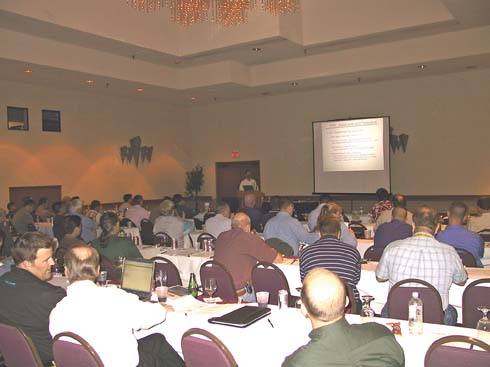 |
| James Young of Rohde & Schwarz
speaks to over 60 people that attended the half-day Tech Tour
seminar, which was hosted by the Phoenix Section. |
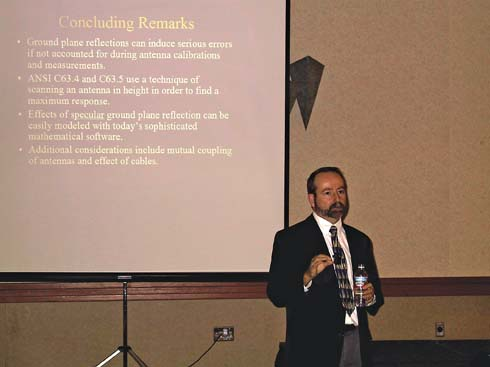 |
| Phoenix Chapter Chair, Harry Gaul,
concludes his presentation with a discussion of other sources
of errors that can occur when performing antenna measurements
and calibrations. |
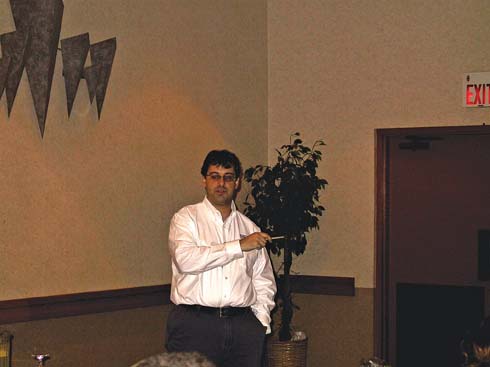 |
| Dr. Vince Rodriguez of ETS-Lindgren
points out the differences in rectangular and tapered anechoic
chambers for antenna pattern measurements to the Phoenix Chapter.
|
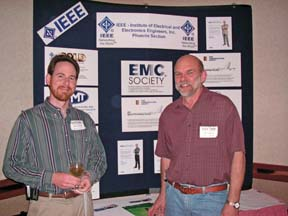 |
| Phoenix Chapter members Steve Gerard
(left) and Jim Dykema, both with General Dynamics, staff the
IEEE membership booth during the reception following the Tech
Tour seminar. |
Phoenix
The IEEE EMC Phoenix Chapter was proud to host the January 2006
RF-EMC-Wireless Tech Tour at the Embassy Suites Hotel in Tempe,
Arizona. The RF-EMC-Wireless Tech Tour is an on-going series of
technical learning sessions that will travel to Melbourne, Florida,
the Metro D.C. area, and to Boston, Massachusetts later this year.
Registration began promptly at 12:30 and it was soon apparent
that this was to be a well-attended event. Once everyone was seated,
the first presentation started on time at 1:00 pm. The first paper
was presented by the IEEE Phoenix Chapter’s own chairman
Harry Gaul, who presented a paper on “The Influence of Ground
Plane Reflection on Antenna Calibration and Measurements”.
This presentation started out with a riddle: Which configuration
is likely to have a better chance of reception given a 2 km distance
between antennas at 450 MHz with a height of 2 meters (assuming
a direct line of sight): across a still lake; across a golf course
with mounds; or would both scenarios be equal? Harry’s presentation
provided the theory and details of performing antenna calibrations
in both free space and ground plane configurations in accordance
with standards such as ANSI C63.5 and SAE ARP958. The concept
of Normalized Site Attenuation (NSA) was introduced as a means
to derive the difference between free space and ground plane test
configurations. Antenna range measurements were also discussed
from the standpoint of how to include the effects of reflection
from earth with finite conductivity. It was concluded that ground
plane reflections can induce serious errors if not properly accounted
for during antenna calibrations and measurements. The effects
of specular ground plane reflections can easily be modeled with
today’s sophisticated mathematical software and additional
considerations should include mutual coupling and the effects
of cables. By the way, the answer to the riddle is that the golf
course is more likely to provide good reception because of the
deep nulls that are possible from the lake. The second paper,
entitled “Anechoic Chamber Solutions for Antenna Pattern
Measurements (APM)”, was presented by Dr. Vince Rodriguez
of ETS-Lindgren. This presentation introduced the attendees to
antenna ranges, and concentrated on rectangular and tapered anechoic
chambers for APM. Rectangular chambers tend to have less critical
source placement, and are the ideal configuration for swept frequency
measurements. Tapered chambers tend to be better for lower frequencies,
but have potentially higher bore sight errors. Absorber technology,
quiet zone levels, and far field requirements were discussed as
well as the proper absorber treatment for both tapered and rectangular
chambers. Large compact range chambers were also discussed. James
Young of Rohde & Schwarz presented the final paper, entitled
“Improving the Accuracy of EMI Emissions Testing.”
This presentation discussed the advantages and disadvantages of
using a spectrum analyzer versus an EMI receiver to make EMI measurements.
Spectrum analyzers must be used carefully due to the possibility
of reduced frequency accuracy over large frequency ranges. For
example, a span of 970 MHz (30 MHz to 1 GHz) results in approximately
1 MHz frequency resolution if the spectrum analyzer has 1001 bins
across its display. Given a 120 kHz CISPR bandwidth over this
range, the bin size is larger than the bandwidth, and frequency
resolution is lost. Additional concerns regarding EMI measurements
with spectrum analyzers include less control of dwell time, potential
3 dB versus 6 dB resolution bandwidths, and less dynamic range
and overload protection. However, the spectrum analyzer is a very
versatile instrument, and may be used for EMI measurements as
long as its limitations are well understood. The presentation
suggested that a spectrum analyzer or test receiver may be used
for initial scanning to make a frequency “hit-list”
as well as for maximization, and that the test receiver is optimal
for making final measurements. The presentation went on to review
the issues of RF and IF overdrive as well as the problems and
benefits of using low noise amplifiers for increased sensitivity.
Once the presentations were complete, a reception was held with
the speakers, including hands on demonstrations and a drawing
for prizes. Congratulations to Dennis Kennedy for winning the
iPod and David Lee for winning the 1GB memory stick. The IEEE
Phoenix Chapter wishes to thank all of those who made the Tech
Tour possible, including the sponsors: Rohde & Schwarz, ETS-Lindgren,
and Conformity Magazine. We would like to thank all of those who
participated in this very successful event, especially TMS Marketing!
Information on future meetings is available on the Phoenix EMC
Chapter Web site at https://www.ewh.ieee.org/r6/phoenix/phoenixemc/.
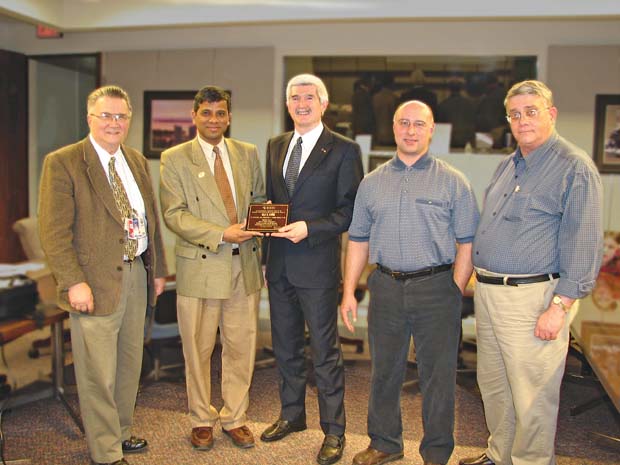 |
| EMC-S Chapter “Angel”
Richard Ford, Past Pittsburgh Section Chair Dr. Kalyan Sen,
speaker Elya Joffe, Pittsburgh EMC-S Chapter Chair Michael
Oliver, and Chapter Vice-Chair Harry Godlewski (from left)
gathered after the inaugural Chapter meeting. |
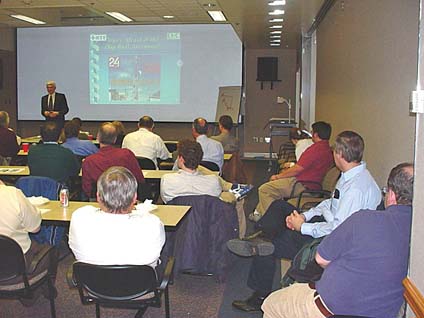 |
| The new Pittsburgh EMC Chapter enjoys
a presentation by Elya Joffe at their inaugural meeting. |
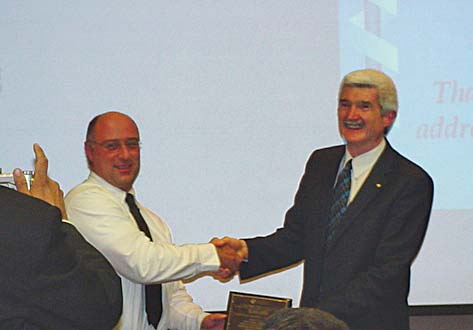 |
| Elya Joffe (right) receives a well-deserved
plaque of appreciation from the Pittsburgh Chapter after speaking
at their inaugural meeting. |
Pittsburgh
The recently formed Pittsburgh Chapter of the EMC Society held
a special two-day inaugural meeting January 31, 2006 and February
1, 2006. The meeting venue was the Westinghouse Energy Center
in Monroeville, Pennsylvania. Michael Oliver, IEEE EMC-S Chapter
Chair, hosted the meeting along with Vice-Chair Harry Godlewski.
The EMC-S Chapter would like to thank Kalyan Sen, PhD for his
expert advice and continued Chapter coordination and support.
The inaugural meeting started with a social prior to the technical
presentation. We had the privilege of having Elya Joffe from K.T.M.
Project Engineering, the VP for Member Services of the IEEE EMC
Society, as our technical speaker, and Richard Ford from the US
Navy, Washington DC as the “Chapter Angel” in attendance
among the 40 plus attendees. Discussions on the first day of the
inaugural meeting encompassed the role of “Chapter Angel”
presented by Richard Ford. Next, a technical presentation was
given by Elya Joffe on “Frequently Asked Questions About
EMC.” Mr. Joffe’s presentation described issues relating
to decoupling strategies, PCB layout, enclosure shielding, and
ground loops. The second day of the inaugural meeting focused
on two presentations by Elya Joffe. The first, “Path of
Least Inductance Principal” described issues relating to
frequency and single point or multi-point grounding, when to ground
a shield at both ends or at only one, and how return current flows
on a PCB not always taking the shortest path. Elya’s second
presentation of the day, “Electrophobia or Why Are People
Really Scared of EM Fields,” described the history of EMF
usage, the evolution of EMR standards, from the turn of the 20th
century to date, and the evolution of public response to EMF and
its usage. The talk addressed this controversial issue from a
user’s point of view concerning the sources of fear, facts,
fallacies, and the risk in risk research. Each of the presentations
was very well received by all. In addition, the attendees received
handouts of the presentations. Many students from Geneva College
attended. Matthew Kennedy, Geneva IEEE President stated, “Events
like this one are a great opportunity for upperclassmen to meet
professionals, and good for attracting underclassmen to the IEEE”.
The future presentation schedule includes some great topics such
as in May 2006: “EMC: An Overview” by Harry Godlewski,
July 2006: “EMI for Working Engineers” and “The
‘Ground’ Myth” by Dr. Bruce Archambeault, September
2006: “The New EU EMC Directive” by Gary Fenical and
October 2006: “Testing for EMC Compliance” by Ed Nakauchi.
Santa Clara Valley
The SCV Chapter was honored to have EMC-S Distinguished Lecturer,
Dr. Ing. Heyno Garbe, University of Hanover, as a speaker for
their April 3, 2006 meeting. The meeting kicked off with dinner,
social time and announcements by the Chapter Chair, Hans Mellberg.
A special announcement was given by Todd Robinson, the Publicity
Chair for the 2006 IEEE International Symposium on EMC, who was
on hand to invite SCV Chapter members to be in Portland 14-18
August 2006. Although the meeting was not held on the traditional
second Tuesday of the month, there was a good turn out to hear
Dr. Garbe’s interesting presentation on the “EMC Challenges
of Local Area Networks.” His talk focused on first identifying
typical EMC and EMC related problems with LANs, such as data symmetry
and poor cable shielding practices. Second, Dr. Garbe outlined
the application of good shielding and data symmetry practices.
Ultimately, Dr. Garbe illustrated that good EMC practices in LAN
cabling and installation translate into better LAN performance.
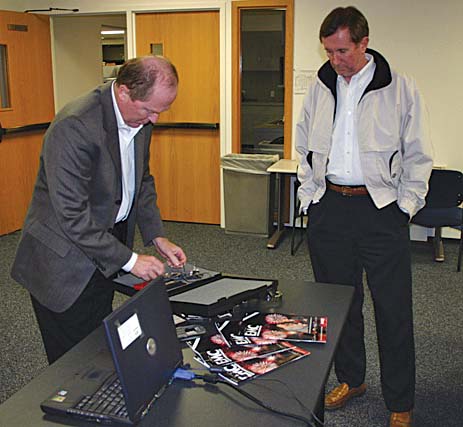 |
| Jim Skelly of Cybershield (left)
prepares for his presentation to the Seattle EMC Chapter in
January. John Kerns of J.J. Associates provides assistance.
The meeting was held at Arrow Electronics in Bellevue. |
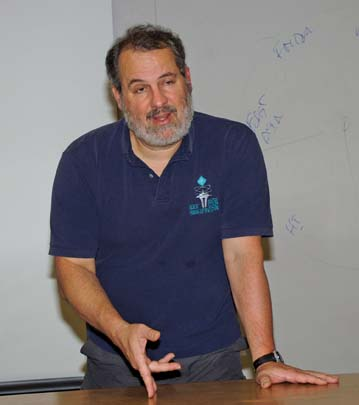 |
| Seattle Section Secretary, Joe Decuir
of MCCI, presented an update on the topic of “Ultra
Wide Band” at the February joint EMC/MTT/AP Chapter
meeting in Seattle. The meeting was held at the University
of Washington. |
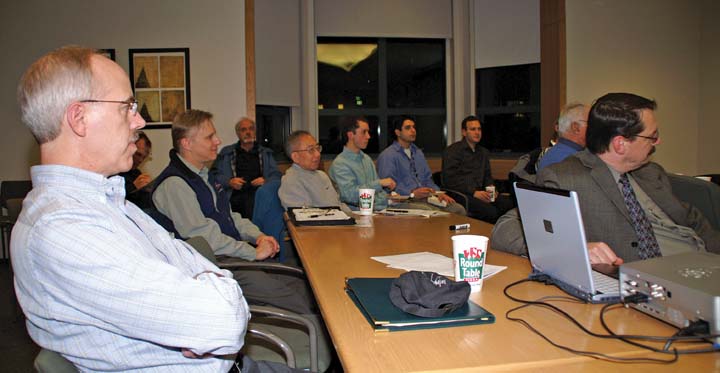 |
| The February Seattle Chapter meeting
drew long time member, Dave Walen of the FAA (left), as well
as Chapter Chair Pat André of André Consulting
(foreground right). |
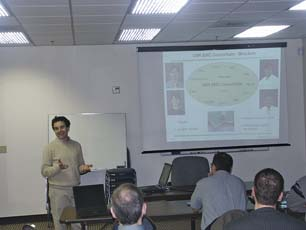 |
| EMC Society Distinguished Lecturer,
David Pommerenke of the University of Missouri-Rolla, was
the featured speaker at the March Seattle Chapter meeting.
|
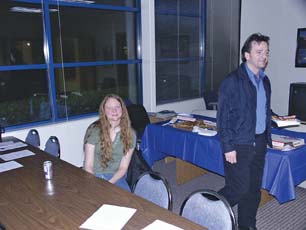 |
| Jaynie Shorb of Zilog and Joel Lachance
of Microsoft enjoyed Dr. Pommerenke’s presentation on
“Advanced ESD and EMI Analysis Methods” at the
Seattle Chapter meeting. |
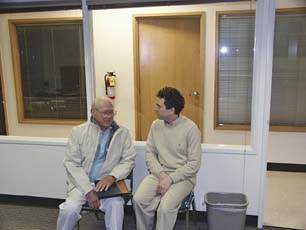 |
| Following the March Seattle Chapter
meeting, Del Black of Del Black Associates (left) visited
with the speaker, Dr. Pommerenke. The meeting was held at
the new CKC Labs facility in Bothell. |
Seattle
The Seattle EMC Chapter kicked off the New Year with a presentation
on January 24 by Jim Skelly of Cybershield. The title was “Conductive
Coatings in EMC Shielding Systems.” It was a very informative
talk on the history of coatings and applications for various types
of coatings with cost versus performance analysis. Several sample
products were distributed to the audience. It was a good review
for those who use plastics and still shield for EMC issues. The
presentation also covered ROHS and WEEE issues related to the
coating process. It was a pleasure having Mr. Skelly as a speaker;
his enthusiasm for his work was truly infectious. The meeting
was held at Arrow Electronics in Bellevue. In February, the Seattle
EMC Chapter held a joint meeting with several Seattle Section
Chapters, including the Microwave Theory and Techniques Society’s
local Chapter. Seattle Section Secretary, Joe Decuir, a senior
engineer with MCCI, a very energetic and capable speaker, presented
an update on the topic of Ultra Wide Band (i.e. 500 MHz bandwidths)
standards. Some of the material presented was updated just that
morning of the meeting! The meeting was held at the University
of Washington. In March, the Chapter was treated to a special
meeting – at the new location of CKC Labs in Bothell, with
an EMC Society Distinguished Lecturer, Dr. David Pommerenke of
the University of Missouri at Rolla, as the speaker. Dr. Pommerenke
spoke on “Advanced ESD and EMI Analysis Methods.”
The attendees learned that there is no single method that allows
identifying all the reasons for EMI and ESD problems. One needs
to be aware of and have experience in a variety of methods and
apply hopefully the most suitable method. The presentation showed
different methods for EMI and ESD analysis, including PCB level
scanning (ESD) and how this relates to IC level and system level
test results. On EMI, Dr. Pommerenke noted that finding the sources
and the antennas is usually not a problem, but understanding and
quantifying the coupling path is sometimes close to impossible.
He presented the use of port impedances and transfer functions
for determining coupling paths and for the measurement of very
hard to measure currents, for example, common mode current on
a differential trace. All agreed it was a great presentation and
all appreciated the hospitality of CKC Labs holding the meeting
at their new facility.
 |
| Professor Sugiura opens the 1st Sendai
EMC Chapter meeting in 2005. |
 |
| Chairperson Professor Takagi and
members concentrate their attention on a lecture at a recent
Sendai Chapter meeting. |
 |
| Attendees at a Sendai meeting gather
with the Chapter flag. |
 |
| A lecture regarding Power Line Communications
was given to the Sendai Chapter at the Tohoku University. |
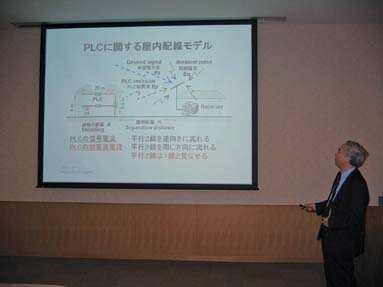 |
| Professor Sugiura makes a point during
his lecture for the Sendai Chapter on estimations of unwanted
radiations. |
 |
| Professor Takagi announces the opening
of the 2nd Sendai colloquium. |
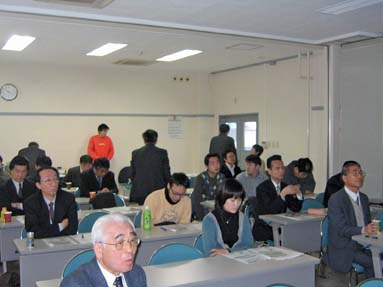 |
| The Sendai Chapter relaxes during
a break between presentations. |
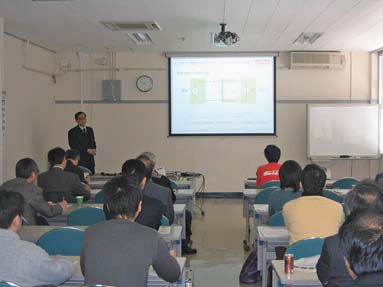 |
| Mr. Yamamoto explains three terminal
capacitors to the Sendai Chapter. |
 |
| Mr. Umemura lectures to the Sendai
Chapter on “Common Mode Filters.” |
 |
| Dr. Wada comments on the future of
EMC technologies at the Sendai EMC Chapter meeting. |
Sendai (Japan)
During 2005, the Sendai Chapter held three technical meetings,
two of which were the IEEE EMC-S Sendai Colloquium and one of
which was the workshop of PLC (Power Line Communications). The
first meeting in 2005 was held on June 26, with two lectures being
presented. First, Professor Osamu Fujiwara of the Nagoya Institute
of Technology spoke about “Static Electricity and EMC.”
Dr. Fujiwara presented remarkable and excellent results of experimental
and theoretical research work on ESD and EMC. Next, a talk entitled,
“Measurements and Analyses of Switching Arc Discharge on
Electric Contacts for Automobile Circuits” was given by
Dr. Junya Sekikawa of Shizuoka University. Dr. Sekikawa showed
some interesting results obtained in his experimental research
on the discharge phenomena at the metal contacts of an electric
switch. Interestingly, he displayed some movies of arc growing
and dancing during the discharge between contacts. The PLC workshop
was held on November 14 and 15 at Tohoku University. Eight specialists
on this topic presented their latest research work relating to
PLC technologies, and discussed the results of a special committee
on PLC in Japan. This workshop was held in cooperation with the
Japan Chapter of EMC-S. Many researchers and over 60 persons gathered
and concentrated their attention on these presentations. The second
colloquium in 2005 was held on December 26 and 27. Professor Osami
Wada of Kyoto University gave a lecture entitled “EMC Design
of Printed Circuit Boards.” This talk included his integrated
research work on current design issues and forecasting for EMC
technologies in the future. Four excellent presentations by EMC
specialists from Japanese companies followed, showing their latest
EMC research work including, “Near Field Measurement for
EMC Countermeasure” by Dr. Satoshi Kazama (Taiyo Yuden Co.,
Ltd.), “EMI Countermeasure of a Micro-Processor-Power System
Which Used a 3-Terminal Capacitor” by Mr. Hidetoshi Yamamoto
(Murata Manufacturing Co., Ltd.), “Common Mode Filter for
High Speed Differential Signal” by Mr. Masao Imamura (TDK
Corporation) and “Novel Noise Solution for Digital Devices”
by Mr. Hiroshi Ono (NEC Tokin Corporation).
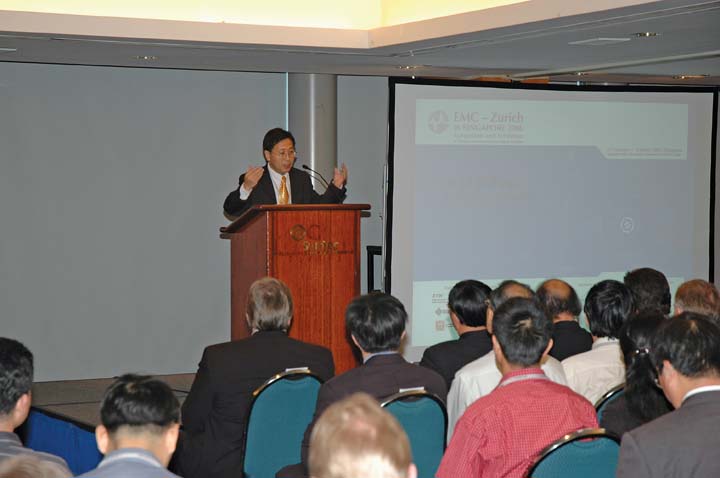 |
| Dr. Li Erping, Symposium President,
during his welcome address at the 2006 EMC Zurich in Singapore
opening ceremony on March 1, 2006. |
 |
| Andrew Drozd, President of IEEE EMC-S,
gave a talk in Singapore on February 27, 2006. |
 |
| Professor Todd Hubing gave his talk
at the IEEE EMC-S “Presidents Meeting” with the
Singapore Chapter. |
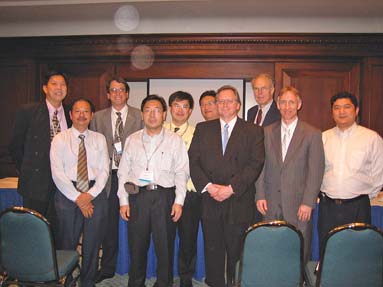 |
| Members of the Singapore Chapter
and guests gathered after the Chapter meeting, including (from
left) See Kye Yak (Singapore Chapter Deputy Chair), Ng Buck
Chew (Chapter Committee member), Mark Montrose (IEEE EMC-S
Board Member), Li Erping (Singapore Chapter Chair), Tim Foo
(Chapter Treasurer), Yan Seow Chiang (Chapter Secretary),
Andrew Drozd (President of the IEEE EMC Society), John Norgard
(IEEE EMC-S Board Member), Todd Hubing (a past IEEE EMC-S
President), and Deng Junhong (Chapter Committee Member). |
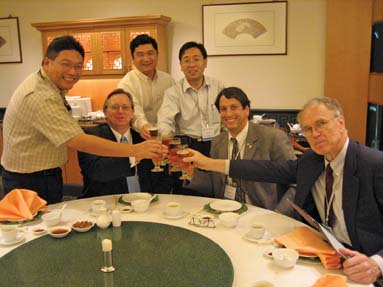 |
| The Singapore Chapter Committee gathers
with the IEEE EMC-S after the “Presidents Meeting.”
From left Yan Seow Chiang (Chapter Secretary), Deng Junhong
(Chapter Committee Member), Andrew Drozd, Li Erping, Mark
Montrose, and John Norgard. |
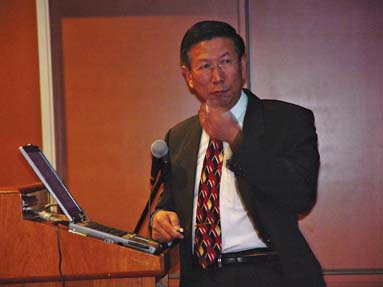 |
| Dr. C. K. Chou’s technical
talk in Singapore on March 7, 2006 was well attended. |
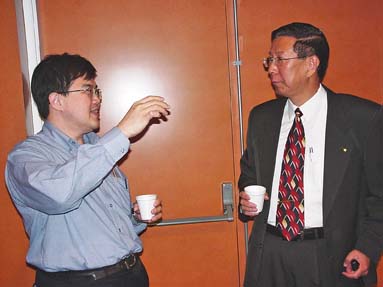 |
| Tim Foo, Singapore Chapter Treasurer,
(left) and Dr. Chou after the March 7th seminar hosted by
the Singapore EMC Chapter. |
Singapore
February and March have been a very busy season for the Singapore
EMC Chapter. To begin with, the Chapter hosted the 17th International
Zurich Symposium on EMC in Singapore, from February 27 to March
3, 2006. The “EMC Zurich Singapore 2006” event was
a great success with over 450 international delegates in attendance.
On February 27, the Singapore Chapter organized a dialogue meeting
between Andrew Drozd, the President of IEEE EMC Society, and Professor
Todd Hubing, Past President of the IEEE EMC Society, and members
of the Singapore Chapter. The meeting took place at the Singapore
International Convention and Exhibition Center, where Dr. Drozd
gave a “State of the EMC Society Message.” Professor
Hubing then delivered a seminar entitled, “Effective Strategies
for Printed Circuit Board Decoupling.” Over 70 EMC professionals
attended the talks, including six Singapore Chapter Committee
members, Li Erping (Chapter Chair), See Kye Yak (Chapter Deputy
Chair), Yan Seow Chiang (Chapter Secretary), Ng Buck Chew (Chapter
Committee member), Tim Foo (Chapter Treasurer), and Deng Junhong
(Chapter Committee Member). Also in attendance were IEEE EMC Society
Board members Mark Montrose, John Norgard, Lee Hill, and Francesca
Maradei. On March 7, 2006, Dr. C. K. Chou, the Chief EME Scientist
of Motorola USA gave a technical talk on “RF Exposure and
Health: Research and Regulations” to over 50 participants.
The meeting was held at the Singapore A-Star Institute of High
Performance Computing.
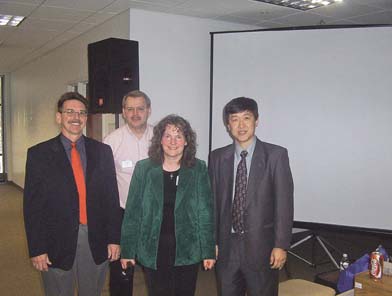 |
| Speakers at the “Basic Antenna
and Probe Use in EMC” workshop presented by the SE Michigan
Chapter included (from left) Paul Zdanowitz of Fair-Rite Products,
Tom Holmes of Agilent Technologies, Candace Suriano of Suriano
Solutions (Workshop Chair), and Zhong Chen of ETS-Lindgren.
Dr. Suriano will also hold this workshop in Portland, Oregon
as part of the 2006 IEEE International Symposium on EMC. |
SE Michigan
On March 2, 2006, the Southeast Michigan Chapter presented a free
one-day workshop titled “Basic Antenna and Probe Use in
EMC.” Presenters included Zhong Chen of ETS-Lindgren, Tom
Holmes of Agilent Technologies, Candace Suriano of Suriano Solutions,
and Paul Zdanowitz of Fair-Rite Products. The workshop featured
hands on demonstrations, empirical data, and great information
to allow attendees to better understand the magic and the theory
of EMC. Over 80 people attended the workshop, despite the terrible
weather, which had closed some roads due to ice and snow that
day. Dr. Suriano has organized this popular workshop as part of
the technical program at previous IEEE EMC Symposiums for several
years now. This year, Chapter Officers encouraged Dr. Suriano
to hold the workshop for her local Chapter! If you’ve missed
this popular workshop, be sure to attend the next one, which will
be held at the 2006 IEEE International Symposium on EMC in Portland,
Oregon. See page 46 for more information. For more information
on the VERY active SE Michigan Chapter, visit www.emcsociety.org.
Everyone is invited and encouraged to attend the Chapter workshops,
meetings, seminars, get involved in the steering committee for
the 2008 IEEE International Symposium on EMC in Detroit, and more!
EMC
|
|
|
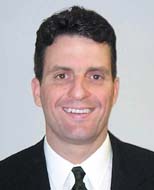 Chapter
Chatter
Chapter
Chatter